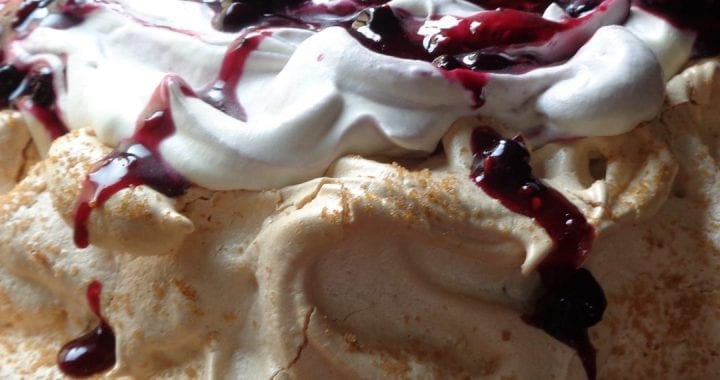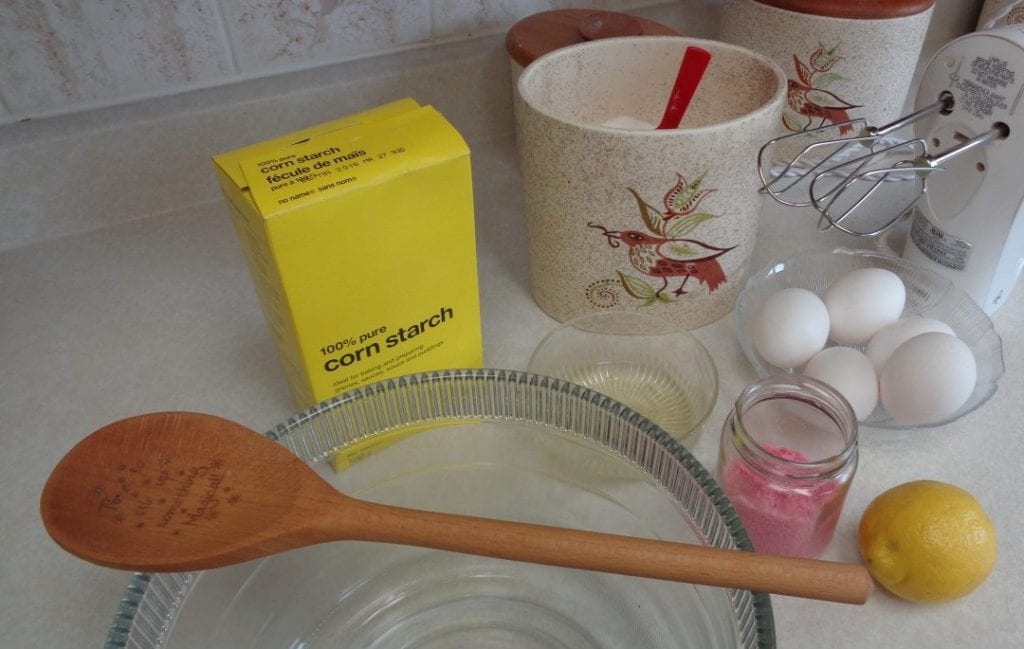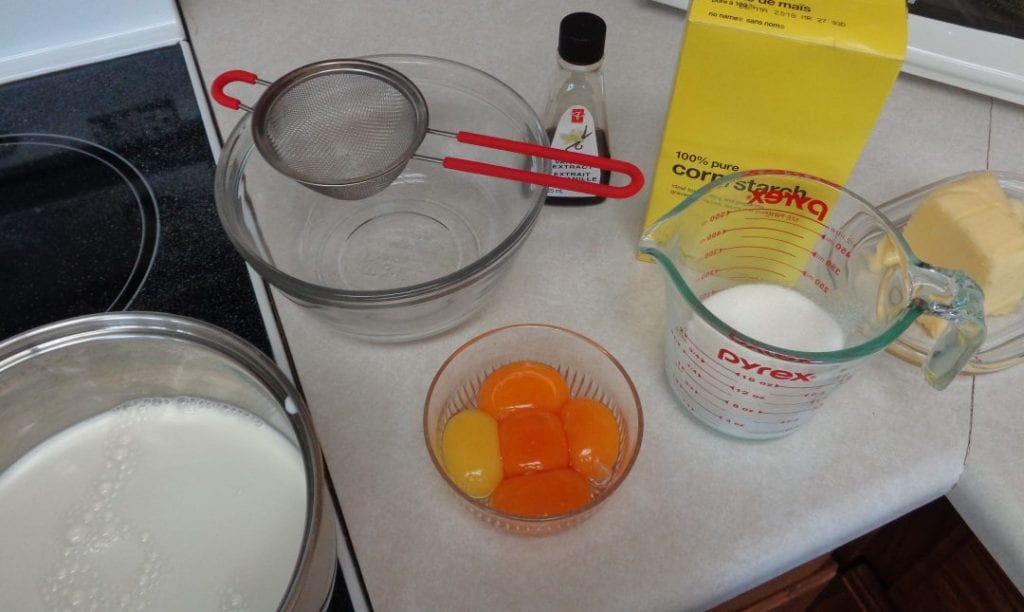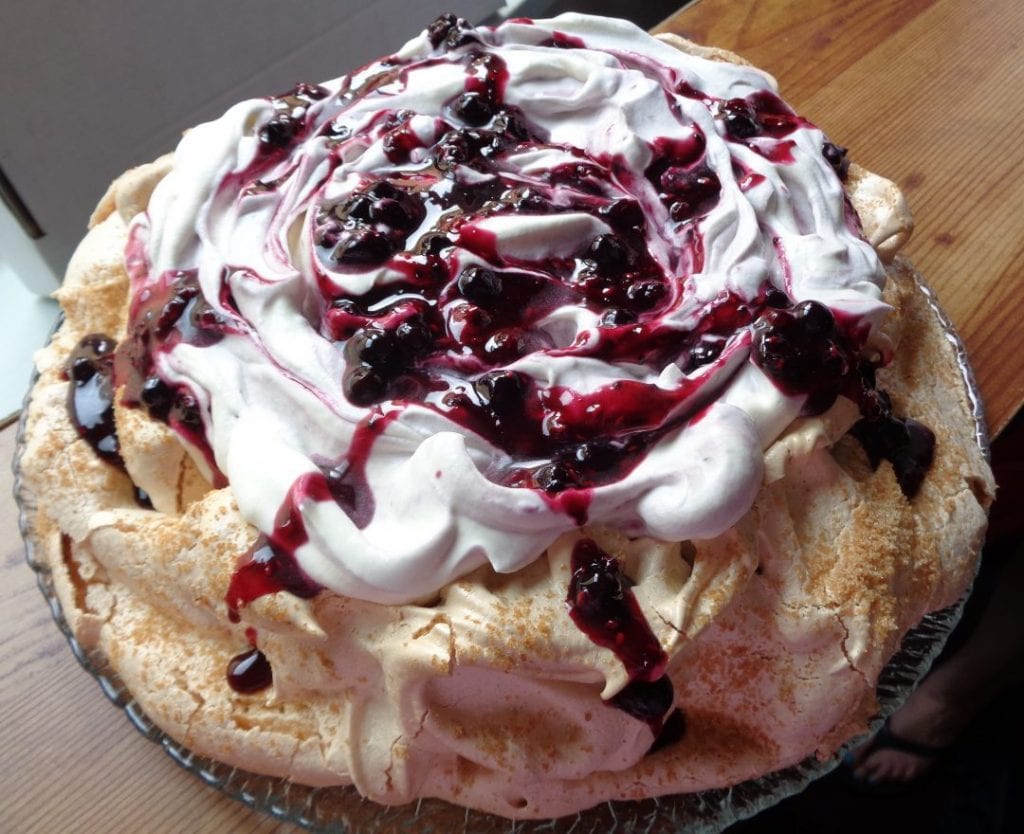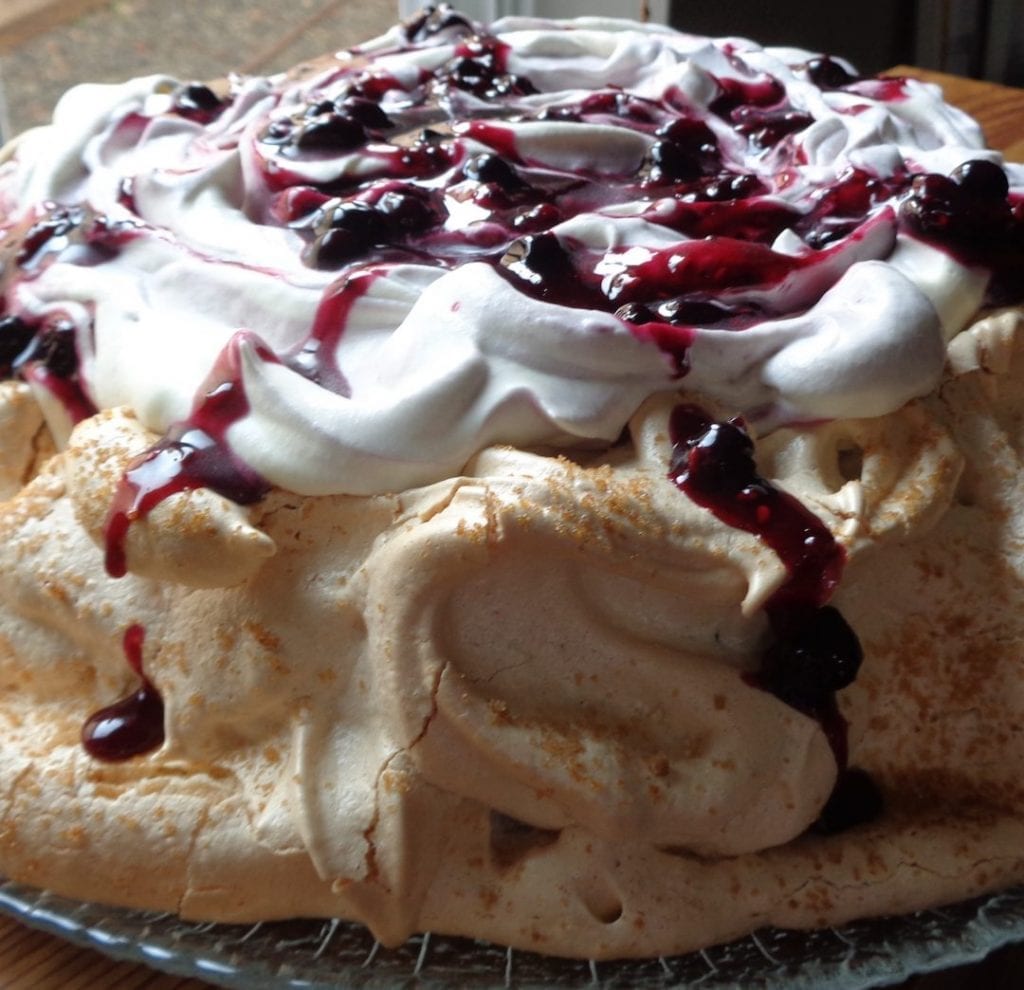It seems to be birthday season around you me right now and my offer of bringing pavlova to the latest celebration was met with immediate agreement. Pavlova is not as well known in North America as it is in New Zealand and Australia where it might almost be considered a national dessert. It is most commonly served with fresh fruit but as berry season is coming to an end up here and black currants can be a bit strong for some, I opted for a sauce instead and hope I have not stepped too far over the line for a traditionalist.
Native to Europe, especially France where it is considered a common flavour and being reintroduced to North America, blackcurrants are still illegal to grow in some states, making them a new found adventure where available. Tart and packed with vitamin C, blackcurrants are little powerhouses of goodness. Turning them into a sauce extends and softens their yumminess.
You will need for the sauce:
1 small box of blackcurrants ( 170 grams/6 oz.)
2 Tbsp. sugar
2 tsp. corn starch
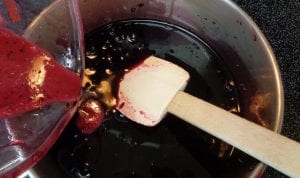 This is a full post so let’s just say, go to your happy place and find peace and gratitude before beginning.
This is a full post so let’s just say, go to your happy place and find peace and gratitude before beginning.
Wash the berries, picking them off their stems and placing them in a small pot along with 3 tablespoons water. Gently bring to simmer and cook for 1-2 minutes, just until the juice starts to run from the fruit.
Combine the cornstarch and sugar with 2 teaspoons of water and return to the pan. The liquids will go cloudy for a short time while the cornstarch thickens and will then clear up again. Stir as the mixture simmers and thickens. Cool in a bowl for later use.
You will need for the meringue:
6 eggs whites
2 Tbsp. shy of 2 cups sugar
1 1/2 tsp. lemon juice
1 Tbsp. cornstarch
Preheat oven to 300 degrees F. Let me start by saying that this was for a party and I wanted to be able to get 12 slices at least. If you do not have the same need, feel free to cut the eggs down to 4 and adjust the other ingredients accordingly. If that path is taken there will be enough sauce and pudding to make two pavlovas of the smaller size.
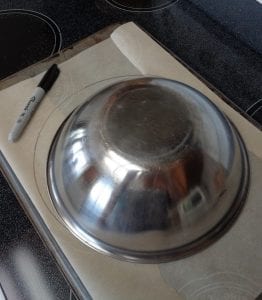 Place a sheet of parchment paper on top of a turned over baking sheet. Using a 10-11 inch bowl or pie plate draw a circle to help with the shaping of the egg whites in this free form meringue.
Place a sheet of parchment paper on top of a turned over baking sheet. Using a 10-11 inch bowl or pie plate draw a circle to help with the shaping of the egg whites in this free form meringue.
Turn the parchment over so that the circle is still visible but the ink will be on the under side, away from the egg mixture.
As the pictures come up, pink will be visible in the bowl of egg whites. It is raspberry sugar.
I posted the recipe last month and substituted 1 cup for the white sugar in the pavlova. No raspberry sugar handy? Just carry on with all white sugar. It was a bit of an experiment and I doubt I would do it again. There was little influence to the tone of the meringue and when unexpected visitors arrived, the extra sprinkled on the outside lost its colour as well.
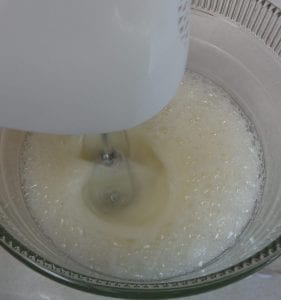 Hold back 1/2 cup of the sugar and mix in the cornstarch. Stir well and out aside. This will make it easier for the cornstarch to blend in rather than just sprinkling it on top of the egg whites later.
Hold back 1/2 cup of the sugar and mix in the cornstarch. Stir well and out aside. This will make it easier for the cornstarch to blend in rather than just sprinkling it on top of the egg whites later.
In order for you to be happy with the finished meringue it is important that the bowl is squeaky clean and that there are no bits of anything in the egg whites as both these situations can affect the finished product.
Gently and gradually shake the sugar over the egg white while continuing to whip the eggs.
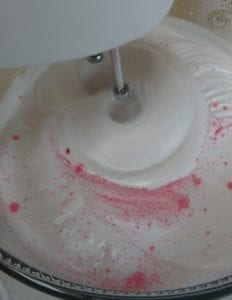 Keeping to about a tablespoon at a time is a good yardstick. The goal is thick and glossy.
Keeping to about a tablespoon at a time is a good yardstick. The goal is thick and glossy.
Whip in the sugar cornstarch mixture and then fold in both flavourings.
The next step is to spoon the mixture into the middle of the circle drawn on the parchment paper.
Starting in the middle, move the mixture toward the outside edge, leaving the center slightly concave and building the outside edges up to hold the filling.
Turn the oven down to 200 degrees and bake for 1 hour, checking to watch for too much colouring. Turn off the oven, open the door a crack and allow to cool further before removing and transferring to a wire rack.
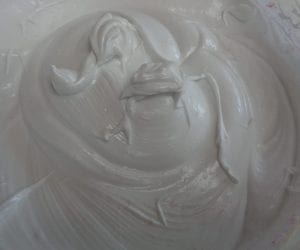 The outside should be crisp and light and you may see a few cracks, all part of the “look”.
The outside should be crisp and light and you may see a few cracks, all part of the “look”.
Pavlova is said to be named after Anna Pavlova a famous Russian ballerina who performed in the 1920’s. As with the histories of many foods, there are differing options.
Germany is also called home to meringue based tortes. However the current version of meringue, cream and fruit came to its present form, pavlova is now a part of summer and a special treat when celebrating in New Zealand and Australia.
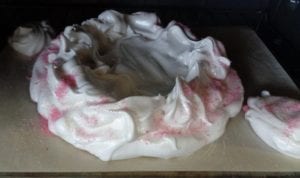 Here summer is coming to an end, so before fall has officially arrived, let’s finish this up.
Here summer is coming to an end, so before fall has officially arrived, let’s finish this up.
I added two small extra meringues so that I could share a taste with those that were not coming to the party. They were a little close as the eggs expand when baked but I could separate them without issues. I also sprinkled with extra raspberry sugar but it was all the same colour by the time the base came out of the oven. If you do this as well, remember that the smaller meringues will need considerably less time to bake, (25-30 minutes)
While the meringue bakes, move on to the next layer. There are many pavlova recipes that call for Chantilly Cream which is sweetened whipped cream in this part of the world but since there were now left over egg yolks, I decided on a filling that is basically vanilla pudding combined with sweetened whipped cream. A third option is a combination of whipped cream and creme fraiche if that is easily available. The choice is yours.
You will need for the filling:
2 cups whipping cream
1 cup vanilla pudding
To make the pudding:
2/3 cup sugar
4 Tbsp. cornstarch
2 1/2 cups milk
4 – 5 egg yolks
1 tsp. vanilla
2 Tbsp. butter
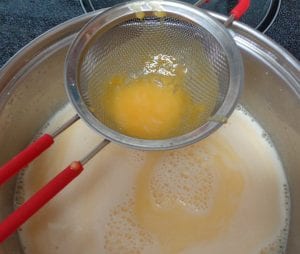 Combine the sugar and cornstarch together in a heavy bottomed pot. (If you choose to use unsalted butter in this recipe, add in 1/4 tsp. salt at this point.)
Combine the sugar and cornstarch together in a heavy bottomed pot. (If you choose to use unsalted butter in this recipe, add in 1/4 tsp. salt at this point.)
Slowly add in the milk, whisking thoroughly all the time.
Stir up the egg yolks and while continuing to whisk pour them through the sieve and into the milk mixture.
Four egg yolks will be just fine. I had used 1 egg white and five eggs for the meringue and wanted to avoid a revolving extra portion of left over egg. I popped the extra yolk into the mix.
Place over medium heat and contribute whisking until the mixture thickens and just begins to bubble. Turn the heat down to low and allow to cook for one minute, making sure the bottom is not burning.
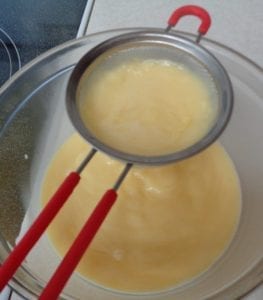 Take the pudding off the heat.
Take the pudding off the heat.
Clean the sieve and place over a medium bowl.
Pour the pudding through the sieve, removing any lumps.
Add in the vanilla and butter to the hot pudding and stir well.
Place a sheet of plastic wrap over the top of the pudding, making sure the pudding is touching the wrap.
This will prevent a skin forming as the pudding cools.
Place in the fridge until cold. If cold pudding is needed quickly, measure out a cup and cool on a plate instead of keeping the full pudding volume together in a bowl.
 When ready to serve the pavlova, whip the whipping cream until firm peaks form and then whip in 1 cup of the pudding into the whipped cream.
When ready to serve the pavlova, whip the whipping cream until firm peaks form and then whip in 1 cup of the pudding into the whipped cream.
Gently fold in about 1/2 cup of the black currant sauce, turning only a few times to create streaks in the whipped cream mixture.
Transfer to the center of the meringue and finish off by drizzling another 1/4 cup of sauce over the top.
Other flavour filled fruits like gooseberries and raspberries can be substituted if they are easier to source.
Blackcurrants, not as common as other berries where I live, give this pavlova an extra bit of flare, delivering a little something different to a 30th birthday.
Happy Birthday Mo!
Blackcurrant Pavlova from My Kitchen Wand

